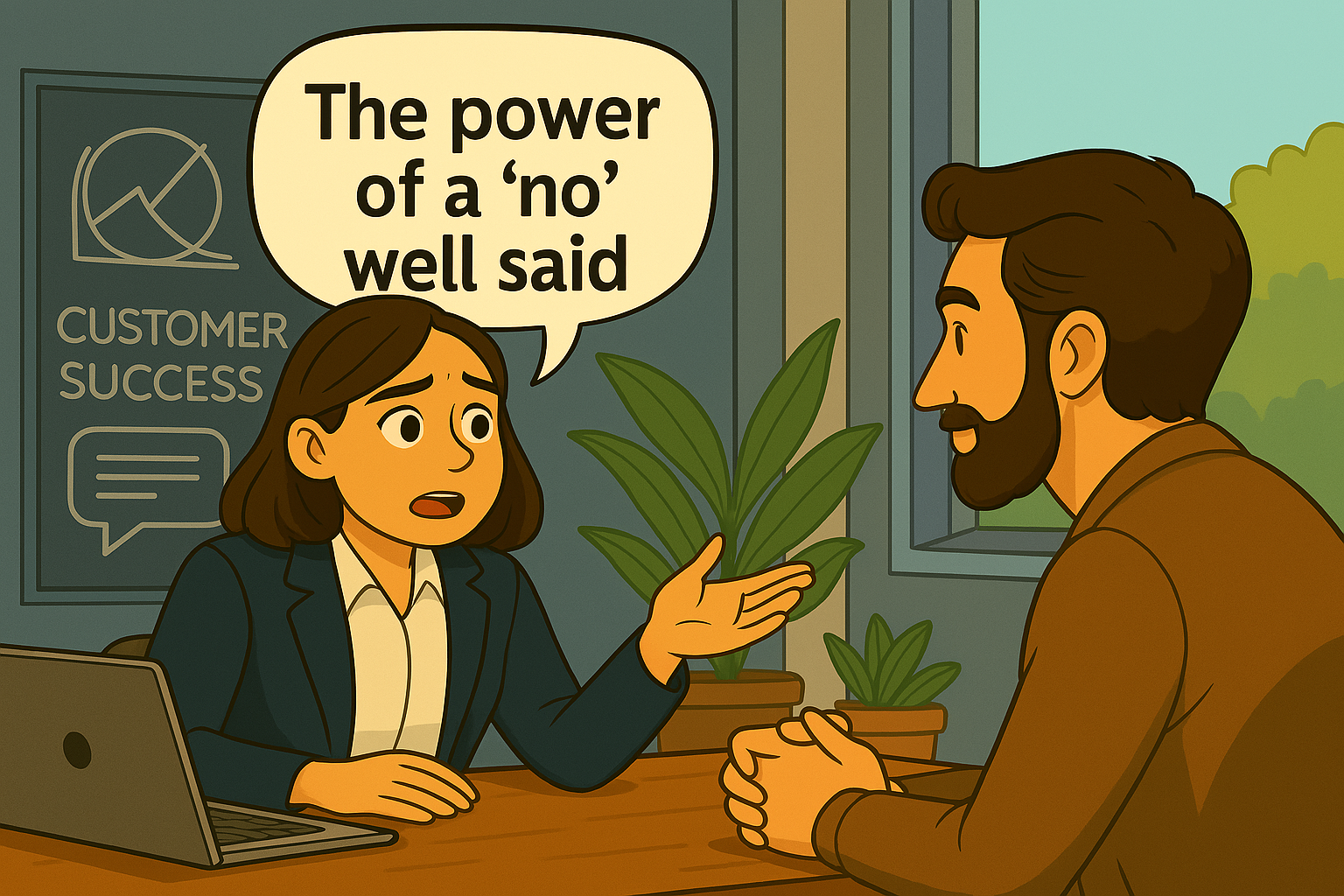
How to way "No" without losing the client: from tension to trust
I still remember that Tuesday. The meeting with the client was scheduled for 10:00 AM, and it was already 9:55. My coffee was cold on the table, and my notes were full of scribbles—clear signs of the tension we had been managing that week. They were one of our most strategic clients, but also one of the most demanding. Working with them had been a constant learning experience… and an emotional rollercoaster.
They had many ideas—valuable, interesting, and all over the place. The problem? Limited resources. Responding to every small request was not just unfeasible, it was risky. It was one of those moments where applying the 20-80 rule—Pareto’s principle—became essential.
But how do you say “no” to so many good ideas without damaging the relationship?
This is the story of how we navigated a delicate situation—and how learning to say “no” became one of our greatest strategic assets.
🚫 The day we said “No” (and what we learned from it)

The client had sent us a list of more than 10 “must-have” requests and comments.
When I read the email, I felt overwhelmed.
Where do we start? What should we prioritize? And how do we manage all these expectations without losing focus or neglecting other clients?
I knew that if we didn’t handle this properly, the cost would be high: we’d lose time, money, and strategic clarity. The temptation to say yes to everything was strong. But:
⚠️ Trying to please everyone is the fastest way to please no one.
🔍 Step one: internal diagnosis
Before impulsively saying “we can’t,” we did what I’ve learned is essential in these situations: we held an internal session and built a quick impact matrix:
- What exactly are they asking for?
- Why do they need it?
- What’s the estimated impact?
- What resources would it take?
- What would we have to drop if we say “yes”?
It quickly became clear that many of the requests had marginal impact but would consume major resources. A few others, however, were highly impactful—both for them and for us.
🥷🏻With this clarity, we were ready for the first tough conversation: what we’d do—and what we had to say “no” to.
🎯 Step two: the client meeting

In the meeting, we didn’t go in defensively. We started with empathy:
“We understand how important these features are for you. And as a growing company, we also need to make strategic decisions to ensure you get the best quality and support where it matters most.”
We then proposed a collaborative session, using our “Impact-Prioritization” methodology and asked key questions like:
“What’s the real expectation behind this feature?” “Can we solve this in a different way?” “What would happen if this feature isn’t available right away?”
This is how we worked:
- Together, we reviewed the feature list in detail.
- We rated each item by impact and effort required.
- We found consensus on what was truly critical—and separated it clearly from the “nice-to-haves.”
🌟 The result was enlightening.
What initially seemed like “everything is urgent” became a short, clear and prioritized list—because in reality, not everything that felt urgent actually was.
📌 Step three: action plan with real dates

But we didn’t stop there. To give weight and value to our “no,” we presented a clear, structured and transparent action plan.
In our second meeting, we delivered a timeline with deadlines, firm commitments, and quick alternatives (workarounds). This created a new dynamic: the client started testing intermediate solutions—and validating what really mattered.
💫 And something interesting happened: by being involved in this process, the client became one of our strongest brand advocates, often highlighting our transparency and willingness to listen.
🧠 What we learned about saying “No”
From that experience, we built a method that we now apply consistently:
- Early transparency: From pre-sales onward, we clarify what’s on the roadmap—and what’s not.
- Collaborative diagnosis: We create shared spaces with clients to identify what’s critical and what can wait.
- Visible, shared action plans: Every “no” must come with a clear Plan B.
- Workarounds to test hypotheses: Interim solutions are powerful tools to manage expectations and validate real needs.
🛠️ Tools that help us manage “No”
- Expectation-alignment sessions: to clarify the real needs behind the requests.
- Collaborative prioritization workshops: to involve the client in decision-making and build shared responsibility.
- Tools like Airtable, Notion, and Confluence: to document, prioritize and follow up on requests and alternatives.
- Ongoing product training: so CSMs are not just customer-facing—they’re product experts too.
- Strategic automation: only after deeply knowing your client—then automate to free time and focus on what really matters.
🚀 From CSM to product expert
This experience reinforced something I’ve always believed—and that I’ll soon expand in another article:
Customer Success Managers are often the ones who best understand the client, who translate real needs into product feedback, and who end up shaping how the product is used.
They turn feedback into strategic input.
They propose quick solutions.
They pivot approaches when needed.
And ultimately, they own the real experience of the product.
But for that to happen, CSMs need training, tools, and autonomy. As I say in the next article:
“Automation is great, but without direction, segmentation, or human insight, it’s just noise. Know your client first—then automate wisely.”
🌱 What I know now about saying “No”
After this experience, I can confidently say: saying “no” isn’t easy, but it’s absolutely necessary.
And if you say it with empathy, clarity and a plan—it not only gets accepted, it builds trust.
“No” doesn’t weaken. It strengthens.
“No” doesn’t distance. It connects.
“No” isn’t failure. It’s professional maturity.
And today, our relationship with that client is more honest, solid and collaborative than ever.
🌟 How to turn “No” into brand advocacy

Those early “no” responses came from a place of radical transparency. We explained the reasons, showed alternatives, and made solid commitments.
The result? Those same clients became our best brand advocates.
A brand advocate isn’t just a satisfied client. It’s someone who trusts you deeply, recommends you confidently—and knows how you show up when things get tough.
That’s why it’s essential to embrace these uncomfortable moments and use every “no” as a moment to deepen the relationship, reinforce transparency and build long-term commitment.
💬 Have you ever turned a “no” into an opportunity?
I’d love to hear your story—share it and let’s keep learning together.
If this article resonates, pass it along. Let’s keep building a stronger Customer Success culture.